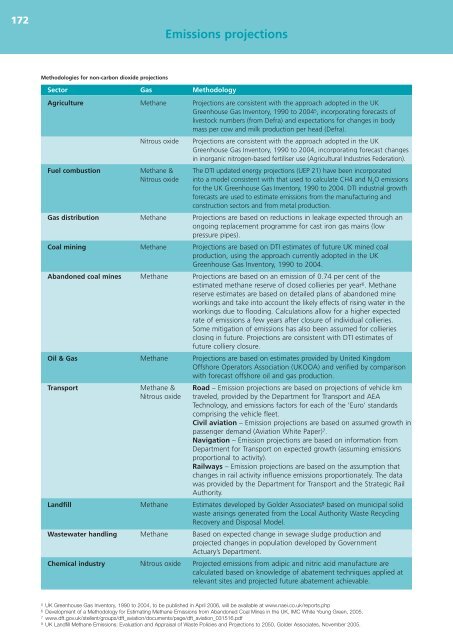UK Climate Change Programme 2006 - JNCC - Defra
UK Climate Change Programme 2006 - JNCC - Defra
UK Climate Change Programme 2006 - JNCC - Defra
You also want an ePaper? Increase the reach of your titles
YUMPU automatically turns print PDFs into web optimized ePapers that Google loves.
172<br />
Emissions projections<br />
Methodologies for non-carbon dioxide projections<br />
Sector Gas Methodology<br />
Agriculture Methane Projections are consistent with the approach adopted in the <strong>UK</strong><br />
Greenhouse Gas Inventory, 1990 to 2004 5 , incorporating forecasts of<br />
livestock numbers (from <strong>Defra</strong>) and expectations for changes in body<br />
mass per cow and milk production per head (<strong>Defra</strong>).<br />
Nitrous oxide<br />
Projections are consistent with the approach adopted in the <strong>UK</strong><br />
Greenhouse Gas Inventory, 1990 to 2004, incorporating forecast changes<br />
in inorganic nitrogen-based fertiliser use (Agricultural Industries Federation).<br />
Fuel combustion Methane & The DTI updated energy projections (UEP 21) have been incorporated<br />
Nitrous oxide into a model consistent with that used to calculate CH4 and N 2<br />
O emissions<br />
for the <strong>UK</strong> Greenhouse Gas Inventory, 1990 to 2004. DTI industrial growth<br />
forecasts are used to estimate emissions from the manufacturing and<br />
construction sectors and from metal production.<br />
Gas distribution Methane Projections are based on reductions in leakage expected through an<br />
ongoing replacement programme for cast iron gas mains (low<br />
pressure pipes).<br />
Coal mining Methane Projections are based on DTI estimates of future <strong>UK</strong> mined coal<br />
production, using the approach currently adopted in the <strong>UK</strong><br />
Greenhouse Gas Inventory, 1990 to 2004.<br />
Abandoned coal mines Methane Projections are based on an emission of 0.74 per cent of the<br />
estimated methane reserve of closed collieries per year 6 . Methane<br />
reserve estimates are based on detailed plans of abandoned mine<br />
workings and take into account the likely effects of rising water in the<br />
workings due to flooding. Calculations allow for a higher expected<br />
rate of emissions a few years after closure of individual collieries.<br />
Some mitigation of emissions has also been assumed for collieries<br />
closing in future. Projections are consistent with DTI estimates of<br />
future colliery closure.<br />
Oil & Gas Methane Projections are based on estimates provided by United Kingdom<br />
Offshore Operators Association (<strong>UK</strong>OOA) and verified by comparison<br />
with forecast offshore oil and gas production.<br />
Transport Methane & Road – Emission projections are based on projections of vehicle km<br />
Nitrous oxide traveled, provided by the Department for Transport and AEA<br />
Technology, and emissions factors for each of the ‘Euro’ standards<br />
comprising the vehicle fleet.<br />
Civil aviation – Emission projections are based on assumed growth in<br />
passenger demand (Aviation White Paper) 7 .<br />
Navigation – Emission projections are based on information from<br />
Department for Transport on expected growth (assuming emissions<br />
proportional to activity).<br />
Railways – Emission projections are based on the assumption that<br />
changes in rail activity influence emissions proportionately. The data<br />
was provided by the Department for Transport and the Strategic Rail<br />
Authority.<br />
Landfill Methane Estimates developed by Golder Associates 8 based on municipal solid<br />
waste arisings generated from the Local Authority Waste Recycling<br />
Recovery and Disposal Model.<br />
Wastewater handling Methane Based on expected change in sewage sludge production and<br />
projected changes in population developed by Government<br />
Actuary’s Department.<br />
Chemical industry Nitrous oxide Projected emissions from adipic and nitric acid manufacture are<br />
calculated based on knowledge of abatement techniques applied at<br />
relevant sites and projected future abatement achievable.<br />
5 <strong>UK</strong> Greenhouse Gas Inventory, 1990 to 2004, to be published in April <strong>2006</strong>, will be available at www.naei.co.uk/reports.php<br />
6 Development of a Methodology for Estimating Methane Emissions from Abandoned Coal Mines in the <strong>UK</strong>, IMC White Young Green, 2005.<br />
7 www.dft.gov.uk/stellent/groups/dft_aviation/documents/page/dft_aviation_031516.pdf<br />
8 <strong>UK</strong> Landfill Methane Emissions: Evaluation and Appraisal of Waste Policies and Projections to 2050, Golder Associates, November 2005.
















